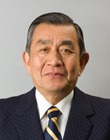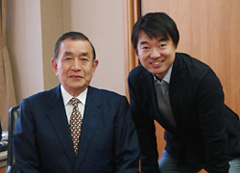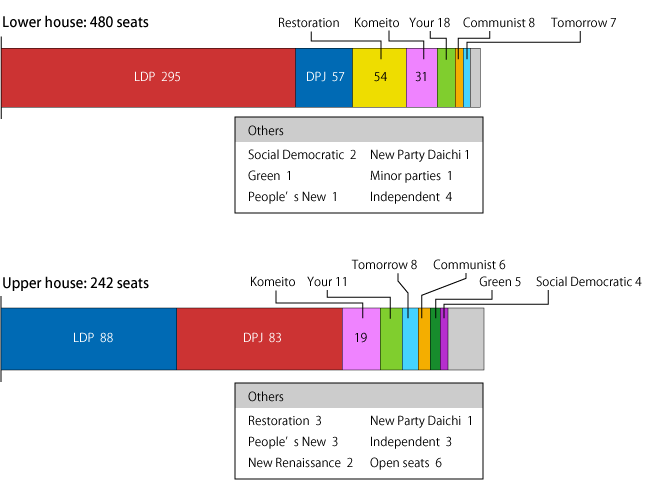Top>Opinion>Reading the Lower House and Tokyo Gubernatorial Double Elections and the Upcoming Upper House Election
 Index
Index

Nobuo Sasaki [profile]
Reading the Lower House and Tokyo Gubernatorial Double Elections and the Upcoming Upper House Election
Nobuo Sasaki
Professor, Faculty of Economics, Chuo University
Area of Specialization: Political Science
Lack of enthusiasm towards landslide elections
While the double elections for the lower house of parliament and governor of Tokyo resulted in landslide victories, they were marked by a lack of enthusiasm. The situation can be summed up by a comment made by Secretary General Ishiba regarding the landslide victory of the Liberal Democratic Party of Japan (LDP): "The landslide victory should not be seen as proof of strong support towards the LDP, but rather as a rejection of the Democratic Party of Japan (DPJ)."
The results of the election for the governor of Tokyo were similar. While the former vice-governor Naoki Inose enjoyed a landslide victory with an unprecedented 4.33 million votes in his favor when he ran as a candidate, the following comment was made by a commentator: "The election only represents him being recognized as a successor for Governor Ishihara, nothing more." I believe the commentator makes a good point. The highly popular Minobe got only 2.2 million votes in his first campaign, while Ishihara only secured 1.66 million votes. The results of these recent elections reflect solo races without any effective rival candidates.
The public supported a full-scale leadership change three years ago in 2009 and entrusted the DPJ with the thorough elimination of wasteful policies. However, the DPJ underwent a transformation and ended up betting it all on a consumption tax increase. This transformation caused a great number of voters to feel betrayed. In a sense, an election is a form of a contract with voters, and the DPJ used its manifesto as a weapon in the election campaign. If a tax increase is required, the proper course in a constitutional government is to appeal to the country before reaching a decision. As the lack of the DPJ's ability to hold the reins of government became apparent, its initial 300 seats dropped to 57 in no time. The voters are by no means blind. They remain ever watchful of the administration. The lesson to be learned by the LDP that was victorious this time and all other politicians is that they must not overlook the fact that in the end it is the voters that call the shots.
How the drama began
The drama began on October 25, when Ishihara suddenly held a press conference to announce that he would resign as Governor of Tokyo. On that day, I got a call from a news agency at about 14:30 while I was at the university office. The agency told me: "I'm not sure if you already know about this or not, but Ishihara is going to have an emergency press meeting in 30 minutes. It is likely that Ishihara will announce the founding of a new party and because the press conference will be broadcasted by some TV stations, we would like you to watch and make a comment." Although I thought the whole thing sounded questionable, when I turned on the TV at 15:00 I was very surprised to see that there were special programs on every channel, including NHK.
Ishihara stated that he would resign as governor as of that day and establish a new party for national politics. Saying nothing of the resignation, the establishment of a new party was a complete surprise for me. Afterwards Tokyo election officials announced that December 16 would be the election day. In fact, this election date affected the national elections.

The first party leader debate between Prime Minister Noda and LDP President Abe was held on November 14. I was on assignment as special advisor for the Osaka City Government at Osaka City Hall on that day. After finishing a meeting held from 13:00 to 15:00 to discuss a districting proposal for Osaka, I went together with Mayor Hashimoto who had been in attendance to the mayor's office. After having a chat with him, we took this commemorative photo together. He had me sit in the mayor's chair and went out of his way to be hospitable.
At that time, Hashimoto was not aware that the lower house of parliament was to be dissolved on November 16. That was not surprising because it came as a bit sudden when Prime Minister Noda mentioned the word "dissolution" during the debate at around 15:30. I do not know how upset he was after that. On August 8, Prime Minister Noda made a pledge that the "lower house of parliament would be dissolved soon," a phrase that grew to become a buzzword and to be viewed as a pledge to dissolve after the year had ended. That was also how Hashimoto had seen the situation at that stage.
In this manner these two dramas converged on December 16 and resulted in quite an unexpected turn of events. I appeared on a special election program on Tokyo MXTV on the election day. I was in the studio from 7:30 to 12:00pm with some other newscasters to present the election results and talk with the winners, losers, and party representatives.
Will the landslide victory of the LDP and Komeito change politics?
As is widely known, the lower house election resulted in a resounding defeat for the DPJ, an overwhelming victory for the LDP and New Komeito and an emergence for Japan Restoration Party and Your Party. The resulting current seat distribution is displayed in the figure below. The ruling LDP-Komeito coalition has 326 seats, accounting for two-thirds of the lower house. That is enough seats for proposing constitutional amendments. However, in the upper house the coalition is 16 seats short of a 102-seat majority (excluding 6 open seats and chairman). This means that Japan continues to have a gridlocked parliament. If passing bills is problematic due to this situation, a government incapable of getting things done as was the case under DPJ leadership could continue.

Figure 1: Ratio of seats in the lower and upper houses (after election)
This series of political dramas could come to an end after the upper house elections in July. Although not as high profile as the lower house election, the summer campaign has been positioned as the strategic point for resolving the gridlocked situation.
So how did the public view the results of the recent lower house election? An opinion poll in published in the Asahi Shimbun newspaper after the election presented some interesting results.
- In response to the question "Are you glad there was a leadership change (from DPJ to LDP)?," 57% answered yes and 16% answered no.
- However, in response to the question "Are you glad the LDP has a majority over two-thirds?," 35% answered yes and 43% answered no.
Looking at the poll results, one gets the sense that some ordinary citizens feel some unease towards the landslide LDP-Komeito victory. As for the cause of the landslide LDP victory, only 7% answered "I supported the policies of the LDP," while 81% answered "I lost faith in DPJ leadership." This presents a much bleaker view than the previously-mentioned comment made by Secretary General Ishiba.
In any case, the average nationwide voter turnout of 59% for the recent lower house election represented an all-time low and was 10% lower than for the previous election. This suggests that independent voters were not very active in this election. In recent elections, the behavior of these voters has had a large impact on results. The proportion of independent voters that voted for "the third power," Japan Restoration Party, was 23% in the proportional-representation section. Only 19.9%, 16.4%, and 14.2% of votes went to the LDP, DPJ, and Your Party, respectively (Kyodo News and exit surveys). However, the single-seat constituency system has a curious effect. While the LDP received 43% of the votes, it has control over 61% of lower house seats. This means that the party has more power than it does public consensus. It will be interesting to see how the upper house election goes this summer.
Battle lines will focus on constitutional reforms, improving relationships between Japan and China, nuclear-dependant power supply and economic recovery, all issues that the LDP has been pro-active towards. However, the question remains as to whether the lavish public works projects that have been started up again will bring the party any luck.
What does having Inose as Tokyo Governor mean?
Another question is how to read the Tokyo gubernatorial election. What I saw was a sterile gubernatorial election without any substantial policy debate. The fact is that we just had a gubernatorial election during April of the year before last. It has only been a year and a half since Ishihara made a tired election pledge to continue doing the things he had done up until then. He then presented us a drama of resigning while he still had two and a half years left in his term. It's a wonder that he has not been criticized for being selfish. Due to this form of resignation that was unprecedented for the administration of Tokyo, the political parties were not able to provide governor candidates. It ended up being Inose that profited from this somewhat abnormal turn of events.
| Rank | Name of candidate (age) | Party | New or present | Number of votes | Percentage of votes | |
|---|---|---|---|---|---|---|
| Elected | 1 | Naoki Inose (66) | Independent | New | 4,338,936 | 65.27% |
| 2 | Kenji Utsunomiya (66) | Independent | New | 968,960 | 14.58% | |
| 3 | Shigefumi Matsuzawa (54) | Independent | New | 621,278 | 9.35% | |
| 4 | Takashi Sasagawa (77) | Tomin No Kurashi O Mamoru Kai | New | 179,180 | 2.7% | |
| 5 | Yoshiro Nakamatsu (84) | Independent | New | 129,406 | 1.9% | |
| Four other candidates | ||||||
| Figure 2: Results of the gubernatorial election | ||||||
So what is the reputation of Inose among congressional sources within the Tokyo metropolitan government? "While he may be the brain of Governor Ishihara, he is not the brain of the Tokyo administration." This was one comment made regarding Inose, who had remained in the vice governor position for a little over 5 years. However, this changed when Shintaro Ishihara, the voice of authority, suddenly announced that Inose would serve sufficiently as a successor.
For a period of a little over 13 years, the Ishihara administration brought in a parade of reforms including fiscal consolidation, diesel vehicle regulations, banking taxes, and public accounting reform. Under the slogan of "Change Japan from Tokyo," Ishihara was entrusted as a strong leader with rebuilding Japan from the Great East Japan Earthquake. Setbacks such as the Olympic bid, the Tsukiji relocation, and the Shinginko Tokyo scandal began to come to the surface during the latter half of the Ishihara administration. Inose played the role of helping Ishihara through these difficulties. Inose worked hard in response to issues including electric power reform, the unification of subway systems, homes with care services, and addressing the risks in densely populated wooden building districts. Perhaps Ishihara's statement that Inose would be up to the job of governor can be thought of as a reward for his efforts.
In any case, Inose's capture of the Tokyo governor's seat can be viewed as a result of a solo race without any clear voter enthusiasm. Over the near term, the Inose administration will likely seek to establish itself by focusing on the bid for the 2020 Olympics. The administration could continue on for eight years if it is successful in the bid. On the other hand if it fails, the administration could be criticized in the same manner as the Aoshima administration, which is looked back upon by some as four years of disappointment caused by thoughtless voting. However things turn out, I do hope that the governor lives up to the expectations that these 4.33 million votes imply and does his best to resolve the issues that lie ahead of him.
- Nobuo Sasaki
Professor, Faculty of Economics, Chuo University
Area of Specialization: Political Science - The author was born in 1948. He acquired a masters from Waseda University Graduate School of Political Science, and a doctor of law from Keio University. After serving in the Tokyo Metropolitan Government Office of Policy Planning, became a professor at Seigakuin University in 1989. He then became a professor at Chuo University in 1994. Served as visiting research fellow at the University of California (UCLA) in 2000, and has served as professor on Graduate School of Economics and Faculty of Economics at Chuo University, since 2001. His specialties are political science and municipal government theory. He concurrently serves on the Science Council of Japan (Political Science) and as a special advisor for the Osaka City and Prefectural Government. His many publications include The Governor of Tokyo [Tochiji] (Chuokoraon-Shinsha), The Japanese Regional System [Doushuu Sei] (Chikumashobo), Local Assembly Members[Chihou Giin] (PHP Shinsho), and Modern Municipal Governments [Gendai Chihou Jichi] (Gakuyo Shobo). Three of his books are scheduled to be published this March: Japanese Public Administration [Nihon Gyousei Gaku], New Shape of the Country - Breaking Away From Central Dependency and the Japanese Regional System [Aratana Kuni no Katachi - Datsu Chuuou Izon to Doushuu Sei], and Big City Administration and Governance [Daitoshi Gyousei to Gabanansu]. He also serves as a commentator for TV and newspapers, including Tokyo MXTV News, and has conducted many lectures across Japan. He has received the NHK Local Broadcast Cultural Award.
- Research Activities as a Member of Research Fellowship for Young Scientists (DC1), Japan Society for the Promotion of Science (JSPS) Shuma Tsurumi
- Important Factors for Innovation in Payment Services Nobuhiko Sugiura
- Beyond the Concepts of Fellow Citizens and Foreigners— To Achieve SDGs Goal 10 “Reduce Inequality Within and Among Countries” Rika Lee
- Diary of Struggles in Cambodia Fumie Fukuoka
- How Can We Measure Learning Ability?
—Analysis of a Competency Self-Assessment Questionnaire— Yu Saito / Yoko Neha - The Making of the Movie Kirakira Megane








